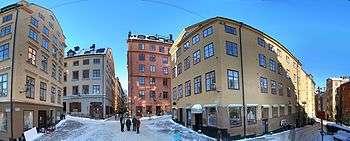Köpmantorget
Köpmantorget (Swedish: "Merchant's Square") is a small public square in Gamla stan, the old town in central Stockholm, Sweden, located between the street Köpmangatan and two slopes collectively named Köpmanbrinken, both of which lead down to the street Österlånggatan. Two streets lead north and south: Bollhusgränd and Baggensgatan respectively.
History
This small square was, notwithstanding the name, never used as a market. Instead, when it first appeared in historical records on a map dated 1733 as Kiöpmanne T., it was named after its location on the eastern end of Köpmangatan, the street leading to Stortorget, the square which used to be the main market place in Stockholm for centuries. Before 1685, the two blocks north and south of the square were united and on the location was a vault (Köpmanvalvet) during the Middle Ages forming one of the city gates (Köpmanporten). The penultimate name referring to the square appears in historical records as late as 1728 in the form Kiöpmans Hwalwet.[1] In 1912, a bronze replica of Bernt Notke's sculpture Saint George and the Dragon was placed in the square. The original is in Storkyrkan.
References
- "Innerstaden: Gamla stan". Stockholms gatunamn (in Swedish) (2nd ed.). Stockholm: Kommittén för Stockholmsforskning. 1992. pp. 58–59. ISBN 91-7031-042-4.
External links

- hitta.se - Location map and virtual walk
